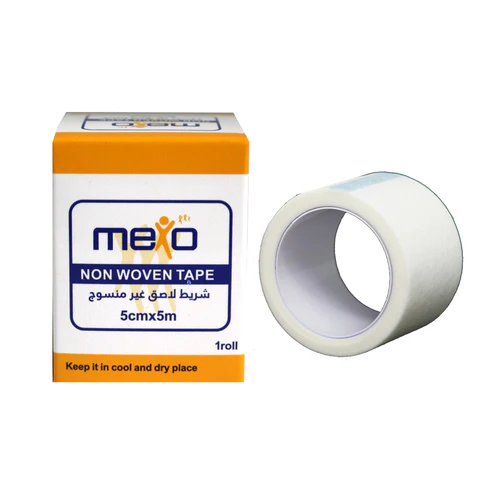Zinc oxide tape is a powerful yet gentle solution for protecting skin, supporting joints, and helping wounds heal faster. Thanks to its unique adhesive and soothing properties, it has become a staple in sports medicine, first aid kits, and everyday wound care. In this article, we’ll explore how it works, when to use it, and why it’s trusted by athletes and caregivers alike.
What Is Zinc Oxide Tape?
Zinc oxide tape combines woven cotton fabric with a zinc oxide adhesive layer, thereby creating a hypoallergenic and breathable tape that sticks well to the skin. Consequently, it is different from other tapes because it helps keep the skin dry and regulated while providing gentle compression. Plus, this adhesive is strong enough that the tape holds securely during physical activity yet can be removed without painful pulling.
Benefits of Zinc Oxide Tape
Using zinc oxide’s tape regularly can provide multiple advantages. Firstly, it reduces friction between skin layers and surfaces like clothing or shoes, thereby preventing blisters and chafing. Secondly, it supports injured joints or muscles, which often speeds up recovery. Thirdly, the tape’s breathability and mild compression help manage swelling while protecting delicate skin areas. As a result, many athletes, dancers, and medical professionals include it in their toolkits.
Common Uses for Zinc Oxide Tape
- Sports and Athletics: Runners, basketball players, and tennis pros often tape their feet, ankles, or hands to prevent blisters and support joints.
- First Aid: It’s ideal for taping dressings on wounds because of its gentle adhesive and ability to stay in place.
- Everyday Protection: Anyone who finds shoes rubbing against the heel or wrist straps that irritate skin can apply zinc oxide tape to reduce discomfort.
- Pediatrics: Parents often use zinc oxide’s tape on children’s heels or toes when they need extra protection during active play.
How to Apply Zinc Oxide Tape
Using zinc oxide’s tape correctly ensures it provides maximum comfort and support:
- Clean the Skin: Wash with soap and dry completely to allow tape to adhere well.
- Measure and Cut: Cut to the required length, rounding the edges to prevent peeling.
- Apply Carefully: Then, lay it down slowly, smoothing out wrinkles and air bubbles.
- Remove Gently: When removing, peel back slowly in the direction of hair growth to reduce discomfort.
Tips for Best Results
- Pre-heat the Tape: Warm a bit by rubbing it between your palms; this improves adherence.
- Layer Smartly: For harder use, add a second layer of zinc oxide’s tape with slight overlap.
- Avoid Sensitive Areas: Don’t use on broken skin or directly over wounds, unless it’s part of dressing.
- Test for Allergy: In rare cases, test on a small patch before larger use, especially on kids.
Zinc Oxide Tape vs. Other Tapes
When comparing, zinc oxide’s tape stands out thanks to its combination of features:
- Compared to athletic tape, it’s less stiff but more skin friendly.
- Unlike fabric adhesive bandages, zinc oxide tape is more breathable and supportive.
- Other medical tapes might use stronger chemicals that increase irritation risk, while zinc oxide tape is often hypoallergenic.
Choosing Quality Zinc Oxide Tape
Here’s what to look for:
- Adhesive strength: Stickiness should be strong but gentle on removal.
- Fabric weight and breathability: Thicker weave = better durability and comfort.
- Sterility or packaging: Ideally sealed in waterproof wrapper.
- Brand reputation: Choose products with good reviews and third-party certifications.
Cost and Availability
Typically, zinc oxide’s tape is sold in single rolls or packs of several. Costs range from affordable generic brands to more premium medical-grade options. Most drugstores, sports stores, or online shops stock it. Because it’s inexpensive and reusable, it offers great value.
Precautions and Safety
Although safe, you should follow a few guidelines:
- Don’t apply with tension, to avoid blood flow restriction.
- Replace tape every 24–48 hours if skin becomes damp or irritated.
- Seek medical help if skin shows signs of allergic reaction or impaired circulation.
- Consult a doctor before using on children under two years.
Comparing Brands and Models
You’ll find many brands, such as Mueller, 3M, and Johnson & Johnson. While some offer extra-wide professional rolls, others stock colorful or patterned versions. Reputable brands undergo testing for adhesive quality and breathability.
DIY and Alternatives
In a pinch, cloth tape plus zinc oxide ointment makes a homemade version. But commercial zinc oxide’s tape offers consistent results thanks to the adhesive’s quality, durability, and tested hypoallergenicity.
Conclusion
Zinc oxide tape is a must-have item for athletes, nurses, parents, and anyone wanting gentle skin protection. It combines breathability, resilient adhesive strength, and a therapeutic impact that few tapes match. Because it prevents blisters, supports healing, and fits a variety of scenarios, zinc oxide tape often becomes a household essential.
Furthermore, with thoughtful application—clean skin, careful smoothing, and prompt removal—you can enjoy all its benefits while avoiding skin irritation. So next time you’re facing chafing, a minor injury, or sports discomfort, reach for zinc oxide tape—it just works.
FAQs Section
Yes, the adhesive stays on during light water exposure. However, swimming for hours may loosen edges.
Most modern zinc oxide tapes are latex-free, but check the label to avoid allergies.
It depends on need. For blister protection, replace daily. For joint support, you can keep it on up to 48 hours.
Yes. Removing it slowly helps reduce discomfort.
Read more: Pallet Collars: The Smart Way to Organize Storage


